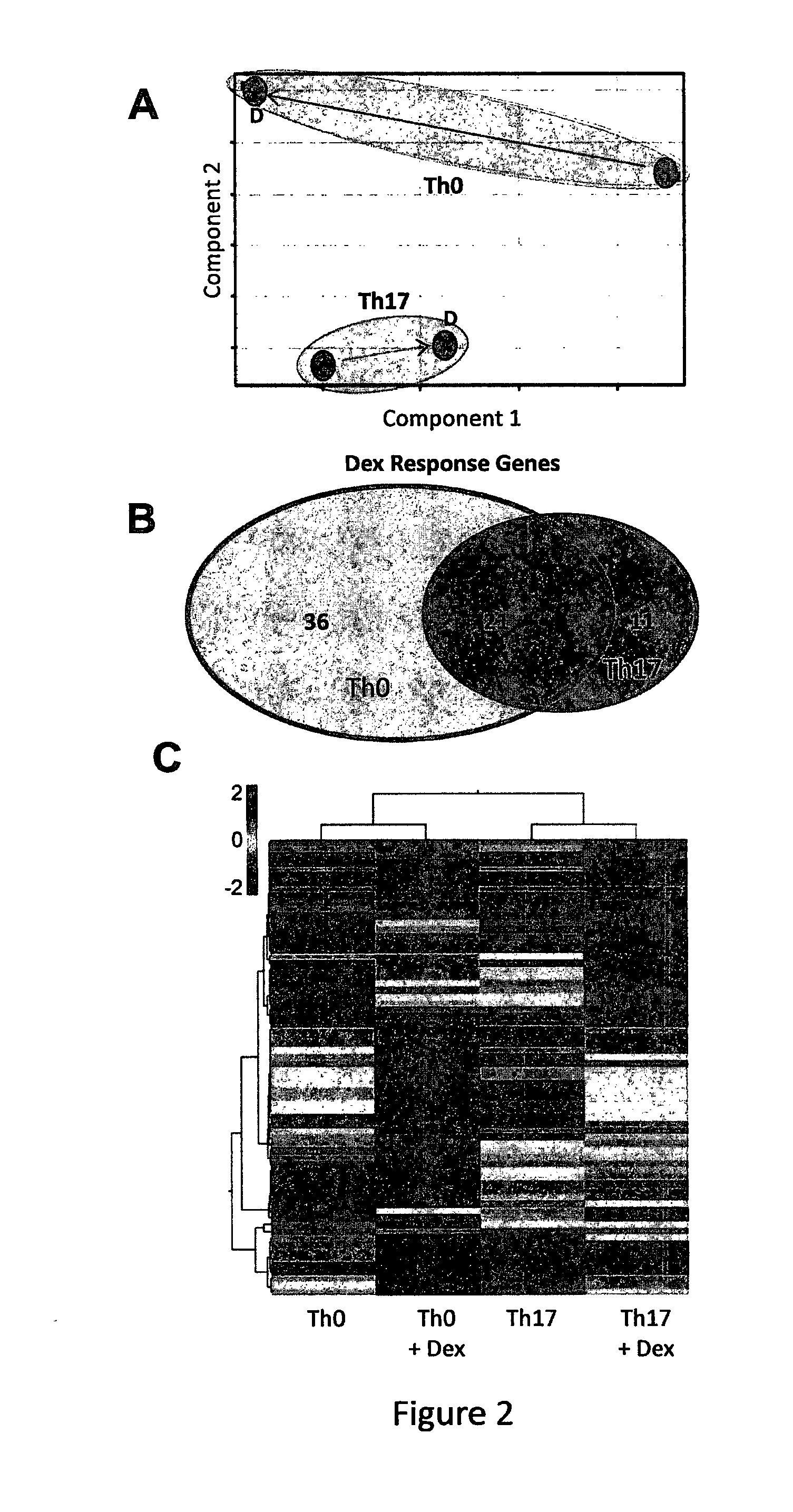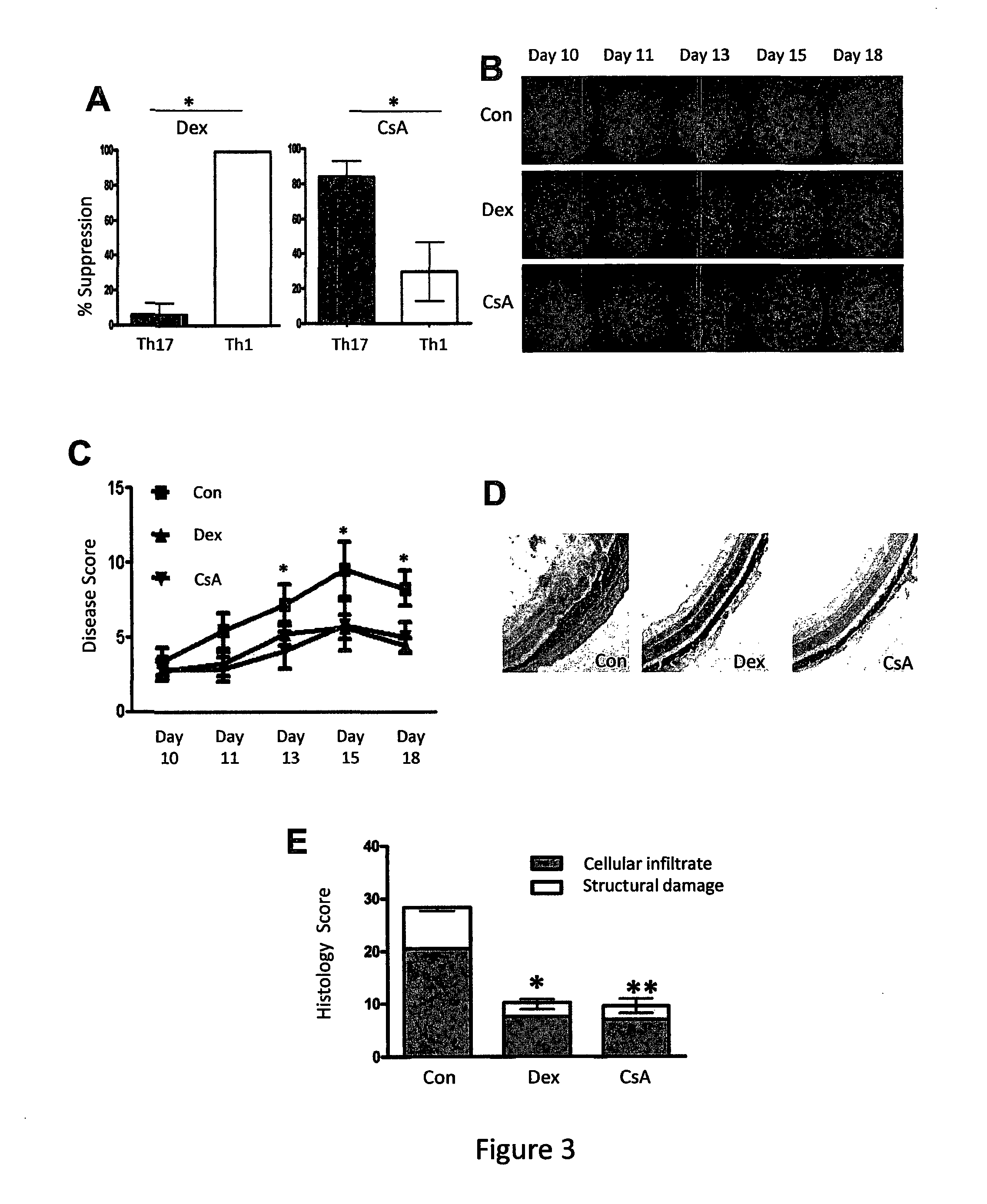Conjugates for treating inflammatory disease and identification of patients likely to benefit from such treatment
a technology of inflammatory disease and conjugates, applied in the field of conjugates, can solve the problems of ineffective steroid treatment, no clinical benefit from myriad side effects of steroid treatment, and significant burden on society for autoimmune conditions, so as to prevent unwanted kidney toxicity, systemic immunosuppression of other immune cell populations, and clinical side effects
- Summary
- Abstract
- Description
- Claims
- Application Information
AI Technical Summary
Benefits of technology
Problems solved by technology
Method used
Image
Examples
example 1
Human Th17 Cells are Resistant to Glucocorticoids
[0111]Previous reports have demonstrated that Th17 cytokines are associated with a decreased PBMC response to glucocorticoids (22) and that in vitro murine polarized CD4+Th17 T cells are non-responsive to glucocorticoids (21). Therefore, to determine whether in vitro, human CD4+Th17 T cells were responsive to glucocorticoids, we generated an IL-17 secreting CD4+ T cell subset using the innate expression of CCR6. CD4+CCR6+ T cells (Th17) were activated and cultured with specific Th17 polarizing cytokines for 7 days and CD4+CCR6− T cells (Th0) were used as a non-Th17 control (less than 1.5% IL-17 production, FIG. 5). Based on our previously published reports (19, 30), we measured the steroid response by the percentage of proliferation inhibition in the presence of the synthetic glucocorticoid, dexamethasone (Dex). Both Th17 and Th0 were treated with Dex for 24 hours and proliferation was quantified by tritiated thymidine incorporation. ...
example 2
Genome-Wide Analysis Reveals a Restricted Response by Human Th17 Cells to Glucocorticoids
[0113]In order to fully characterize the effect of glucocorticoids on Th17 and Th0 cells, we performed gene expression profiling analyses using Affymetrix U133 2.0 GeneChips. As previously carried out, Th17 and Th0 cells were cultured with Dex for 24 hours and then harvested for analysis. A total of 24 samples were analysed (6 matched sets of polarized cells each with and without Dex) Principal Component Analysis (PCA) demonstrated that the genome wide expression change induced by Dex treatment in Th17 cells was significantly restricted compared to the Dex response in Th0 cells (FIG. 2A). Similarly, the total number of genes responding to Dex (defined as a 2-fold change with a p-value of <0.05) in Th17 cells was much less than in Th0 cells (FIG. 2B) The majority of genes (36) were differentially expressed only in the Th0 subset following Dex treatment. Moreover, hierarchical clustering analysis ...
example 3
Murine Th17 Cells are Resistant to Dex but Susceptible to Calcineurin Inhibition
[0114]To confirm in vivo that Th17 cells are unresponsive to treatment with glucocorticoids, our next step was to determine whether Th17 cell driven inflammation was SR and further, to test whether SR Th17 cells could be overcome using calcineurin inhibition. Therefore, we employed the murine platform, Experimental Autoimmune Uveitis (EAU) to investigate this. We first tested that our in vitro observation of continued Th17 cell proliferation in the presence of Dex was replicated in polarized murine CD4+ T cells expressing two types of specific T-cell receptors (OT-II and HEL-Tg) and consistent with our human data, murine Th17 cells derived from both transgenic mice were resistant to glucocorticoid suppression of proliferation. However, with treatment of the cell subsets with the calcineurin inhibitor, Cyclosporine A (CsA), the opposite response was observed. Th17 cells were fully suppressed at a drug dos...
PUM
| Property | Measurement | Unit |
|---|---|---|
| dissociation constant | aaaaa | aaaaa |
| dissociation constant | aaaaa | aaaaa |
| dissociation constant | aaaaa | aaaaa |
Abstract
Description
Claims
Application Information
 Login to View More
Login to View More - R&D
- Intellectual Property
- Life Sciences
- Materials
- Tech Scout
- Unparalleled Data Quality
- Higher Quality Content
- 60% Fewer Hallucinations
Browse by: Latest US Patents, China's latest patents, Technical Efficacy Thesaurus, Application Domain, Technology Topic, Popular Technical Reports.
© 2025 PatSnap. All rights reserved.Legal|Privacy policy|Modern Slavery Act Transparency Statement|Sitemap|About US| Contact US: help@patsnap.com



